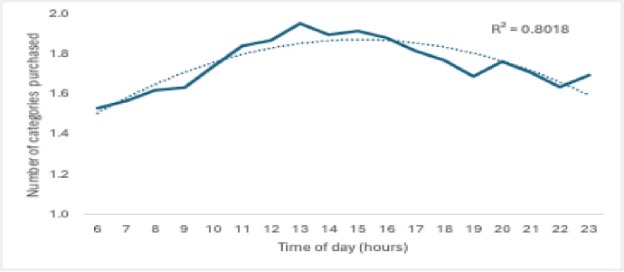Afternoon Cravings: How Time of Day Affects Variety-Seeking Behavior
Relevant topics Research, Archive
In the world of consumer psychology, variety-seeking behavior is the tendency of people to look for new and diverse products, services, or experiences. It plays a significant role in how customers decide to buy products and services, but this behavior tends to shift depending on the time of day.
Have you ever wondered why McDonald’s rotates its menus or why Amazon has Lightning Deals that offer huge discounts at certain hours of the day? They don’t do all that for no particular reason. These are strategies influenced by the psychology of seeking variety.
In this article, we’ll cover the importance of variety-seeking behavior and the psychological concept behind it. We’ll also discuss tips you can try to use this principle to improve your marketing and sales efforts.
How the time of day influences variety-seeking behavior
Consumers’ variety-seeking behavior has been a concept frequently used to inform various marketing strategies. According to data from Google, 88% of consumers say that product selection and product variety are important to them when they’re choosing a brand or retailer to shop from.
With so many brands competing on the market, product variety is one of the ways they can make themselves stand out and attract a diverse range of customers.
Having a wide range of products and services to offer is also a win for your customers because people often seek variety. But did you know that consumers’ tendencies for variety-seeking can be influenced by certain factors like the time of day?
Some studies have looked into how the time of day at which people make purchases affects consumers’ variety-seeking behavior. However, research on the factors that influence this phenomenon tends to yield different results.
One study proposed that variety-seeking behavior is affected by the shift in arousal levels depending on the time of day. It also theorized that having low arousal levels, such as in the morning, is what leads to more variety-seeking as a way to compensate for under-stimulation. However, a different study theorized the opposite: high arousal levels, which tend to occur around midday, lead to more variety-seeking to match the higher stimulation levels.
A more recent study by Giang Tue Trinh replicates the research to compare the two competing theories and examine how variety-seeking behavior changes depending on the time of day. The study used a dataset from the UK that tracks individual purchases for out-of-home consumption of food and drinks at different times of day over three years. The results were more consistent with the second theory, which suggested that variety-seeking increased around midday.

The graph above shows that variety-seeking increases from morning to midday, peaking before dipping after lunchtime, then stabilizing in the afternoon. This indicates that during the early morning, customers tend to favor familiarity over novelty, while around midday, they’re most eager to explore new options.
Timing your offers to match customers’ variety-seeking tendencies
How well your marketing promotions are received can hinge on when customers are most mentally open to trying something new. That’s why marketers use their knowledge of variety-seeking behavior to figure out when, where, and how they should promote their brands to their target customers.
According to the replication study, people become more receptive to novelty and variety as the day progresses from morning to midday. This suggests that customers might settle for their usual orders at 8 AM but scroll through other options or potentially impulse-buy something by noon or after lunch.
Marketers can benefit from this psychological phenomenon by aligning campaigns with consumers’ buying/engagement patterns. It involves showing up exactly when your audience is most likely to engage.
Limited-time offers, rotating lunchtime deals, or even afternoon flash sales are all effective ways to match your audience’s variety-seeking behavior. However, note that timing is only one piece of the puzzle. It’s also essential to consider other factors like market trends and the customer journey when marketing your products and services.
Those who encourage variety and trying something new
Integrating variety-seeking behavior in marketing strategies has proven effective for companies like McDonald’s, Amazon, and Spotify. McDonald’s, for example, rotates its menu to offer different food and drink options depending on the time of day.
McDonald’s has a breakfast menu in the morning, which has a fairly wide range of breakfast items, but not too many, since customers’ variety-seeking behavior isn’t as high during that time. The breakfast menu is only up from early morning until 11 AM, after which it switches to the main menu, which has more options for customers to choose from.
Amazon, on the other hand, makes use of the variety-seeking phenomenon by offering Lightning Deals. These deals are limited-time discounts offered on all kinds of products available across Amazon stores. Lightning Deals are time-sensitive and can last for as little as a few hours, which triggers urgency and encourages customers to explore the deals and make spontaneous purchases. With limited-time deals and big discounts, Amazon taps into customers’ increased decision-making motivation and willingness to explore.
Spotify also uses its listeners’ variety-seeking behavior when promoting various playlists. The streaming platform understands that people seek out variety and uses that knowledge to switch up recommended playlists throughout the day.
For example, in 2023, Spotify introduced “daylist”, a unique playlist tailored to each listener based on which music and genres they listen to during particular moments in a day or on specific days in a week. The daylist updates frequently, between sunup and sunset, with hyper-personalized recommendations for each listener.
When many choices become too many
Customers’ variety-seeking behavior and companies’ product variety go hand in hand. With strategically timed marketing efforts, business owners can make it so that their limited-time deals and promotions reach their customers at the right moment. However, while it’s great to have product variety to cater to customers, it’s important to remember that having too many options could also drive customers away.
One study shows that product variety initially leads to increased sales, but the increase occurs at a diminishing rate. Once product variety reaches an “optimal” point and goes beyond it, increased variety at that point results in lower sales. As the saying goes, there is “too much of a good thing.” Offering various options to your customers is good, but there is such a thing as offering too many.
Leveraging variety-seeking behavior and the power of timing
As we’ve seen, the time of day affects variety-seeking behavior, which is one of the many factors that heavily influence consumers’ shopping habits. By understanding and taking advantage of the shift in variety-seeking behavior throughout the day, marketers and business owners can create timely promotions and product deals to cater to their customers’ desire to try something different. Whether it’s through rotating menus or promoting limited-time discounts, delivering these offers at the right place at the right time is key.
Essential takeaways:
Keep these tips and insights in mind when brainstorming for your next campaign and limited-time offers:
- Variety-seeking behavior can be influenced by many different factors, including the time of day. Understanding your target market and examining how often they make purchases at certain times of the day can help you figure out how to time your marketing efforts. This can help you determine when and how to market your brand to make sure that your customers see your promotions at the right time — that is, at the time of day when they’re more eager to explore.
- Having product variety is great for customers who like having different options when choosing which brands to buy from. However, you should also consider that having too many options could overwhelm customers and drive them away. You need to be able to figure out the optimal level of product variety for your brand so you can offer different products and services without scaring your customers with too many choices.
Further Reading
-
The Power of Sound: How Sonic Branding Boosts Your Brand
Think about Netflix’s "Ta-Dum," NBC’s iconic Chimes, McDonald's "I’m Lovin’ It" Jingle, or T-Mobile’s catchy tune at the end of commercials. Chances are, you can hear each of these sounds in your head just by reading their names.
Consumers are constantly bombarded with ads and cutting through the noise has never been more challenging. But what if the key to cutting through the noise isn’t in what you see, but in what you hear - sound itself? Enter Sonic branding.
-
The Rise of Virtual Influencers and Why We Actually Feel Something for Them
A few weeks ago, I stumbled across a bee on Instagram. Not just any bee — @Bee_nfluencer —a quirky, non-human virtual influencer buzzing about environmental change. I laughed, I clicked, I followed. I didn’t expect to feel anything, but oddly enough, I did.
That moment made me pause. Why did I connect with a cartoon bee?
It turns out, there’s a psychological reason for this — and a powerful one at that.



